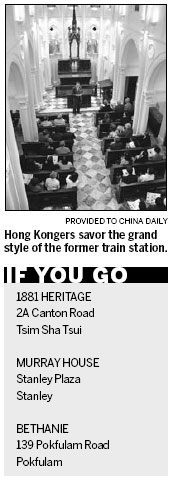New life for blasts from the past

Hong Kong
History buffs often bemoan Hong Kong's lack of foresight for preserving its architectural heritage. In the early 1970s, the gracious red-brick colonial rail station that was the terminus for a network of trains running from the tip of Tsim Sha Tsui all the way through China, Russia, Europe and beyond was reduced to a mere clock tower. More recently, the beloved Star Ferry pier has been replaced with a bypass on reclaimed land. But all is not completely lost. These days, the city is more sensitive to conserving its architectural gems, breathing new life into colonial relics.
One controversial conversion is the former Marine Police Headquarters Compound into 1881 Heritage. The large complex spans Salisbury Road to One Peking Road, and Canton Road to Kowloon Park Drive, and was occupied from 1881 until 1996. In 2003, developer Cheung Kong Holdings won the tender to revitalize the site according to international conservation standards. Six years later, the first tenants moved in.
The original structures consist of the main building, stable blocks, time-ball tower, fire station and fire station accommodation block. As the area is prime tourist territory, the lower parts of the site house a number of luxury boutiques, including Shanghai Tang, Tiffany & Co and Cartier. The upper section is crowned by Hullett House, a boutique hotel operated by Aqua Group that boasts a bevy of restaurants and bars. Although critics scoff at 1881 Heritage as a Disney-fication of a historical site, it has been a hit with tourists. And it is preferable to demolition.
Another approach: Move the building. Originally built in 1846, Murray House's Central site became much too valuable for its purpose as officers' quarters. In 1982, the building was dismantled piece by piece to make way for I.M. Pei's Bank of China building. Each of the more than 3,000 pieces was faithfully catalogued and, in 2002, the building was resurrected in Stanley. Today, the bottom floor houses the Hong Kong Maritime Museum, while its upper floors are al fresco restaurants with broad sea views.
In 2007, Murray House was joined by Blake Pier, also formerly in Central and relocated to Stanley after a 40-year stint as the roof of Morse Park pavilion. A fitting companion to Murray House, Blake Pier offers ferry services to nearby islands.
Built between 1873 and 1875 by French Mission architect Father Pierre-Marie Osouf, Bethanie in the green Pokfulam was originally conceived as a place for priests to recuperate from tropical diseases. Along with two octagonal Dairy Farm cowsheds built in 1886, the government granted Bethanie to the Hong Kong Academy of Performing Arts in 2003. The entire complex underwent extensive restoration, led by architect Philip Liao. It reopened in 2006 with facilities for its film school and a restored chapel - now it's a hotspot for weddings and events.
Liao is now working on the revitalization of the former Tai O Police Station into a heritage boutique hotel, with an opening planned late this year.
For China Daily
(China Daily 02/27/2011 page15)














